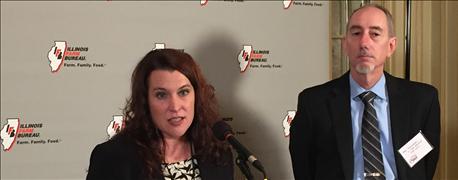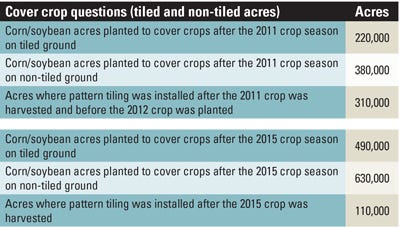
Good news: Illinois farmers using maximum return to nitrogen (MRTN) application guidelines have increased from 70% to 81%.
Bad news: Nearly 24% of Illinois farmers say they have slight or no knowledge of 4R nutrient management.
Further good news: Cover crop use in Illinois on tiled ground more than doubled from 2011 to 2015.
Further bad news: Those acres — 490,000 — still represent less than 5% of Illinois farmland (see chart below).

RESULTS: Julie Armstrong, Illinois Nutrient Research and Education Council, announced results of a 2015 producer survey at the Illinois Farm Bureau annual meeting. The survey collected data on how farmers' nutrient practices have changed since 2011. Farmers using MRTN application guidelines have increased from 70% to 81%. And while Illinois farmers have doubled cover crop use since 2011, cover crops are only used on 5% of tiled ground, according to Mark Schleusener, Illinois state statistician and director of the survey.
That’s according to results from a new study conducted by USDA's National Agricultural Statistics Service in Illinois, looking at how farmers’ nutrient practices have changed since 2011, and funded by the Illinois Nutrient Research and Education Council and Illinois Farm Bureau.
Says NREC Director Julie Armstrong, “We weren’t necessarily surprised by the results, but we are relieved to see things have moved forward. We’ve made a lot of progress.”
She explains that until now, the industry only had anecdotal evidence of farmer use and adoption of nutrient management practices. This study, headed up by Illinois State Statistician Mark Schleusener, surveyed 1,900 farmers on the change in their practices from 2011 to 2015, and was conducted by an independent third party — something Armstrong says is important for both the government and the industry to use in response to calls for environmental action.
“We’re the umpire in the baseball game, not the fan,” Schleusener says.
For her part, Armstrong is thrilled to have real numbers. “Every ag group is so focused on improving nutrient management, but how far are we getting?” she asks. “We can use this survey and the USDA to validate anecdotes.”

Schleusener says that while they did not ask farmers what best management practices they’re using, they did collect MRTN statistics and looked closely at timing of fertilizer applications. Among those results: Acreage that received zero fall/winter nitrogen and instead received 100% of its N throughout the spring went from 2.48 million acres in 2011 to 2.66 million acres in 2015. Acres where nitrification inhibitors were used dropped from 3.24 million acres in 2011 to 2.97 million acres in 2015, though Schleusener says that’s likely due to less fall nitrogen application.
Armstrong says they will use the data to help NREC set priorities. Results showed them they need to spend more time increasing awareness of and education about cover crops and edge-of-field practices with farmers. She says NREC will look to certified crop advisers, soil and water districts, and Extension advisers to help share information. “They’re a trusted a resource, and that may be why we’ve seen greater adoption of the 4R program,” she adds.
“Ultimately, we are measured on success with water quality,” she says. “Now we have information to make good decisions.
The 4R Nutrient Stewardship approach encourages farmers to choose the right nutrient source to apply at the right rate, in the right place, at the right time. The Illinois Nutrient Loss Reduction Strategy was developed to reduce nutrient loss to Illinois waters and the Gulf of Mexico, and calls for a reduction of phosphorus load by 25% and nitrate load by 15% by 2025.

KNOW: Some 75% of Illinois farmers reported that they were either very knowledgeable, knowledgeable or somewhat knowledgeable about the 4R nutrient management strategy. And the remaining 25%? NREC’s Julie Armstrong says some people will lag behind, but her organization continues to look for ways to reach them. “When it comes to this issue, there’s never enough outreach and never enough connection.”
About the Author(s)
You May Also Like






